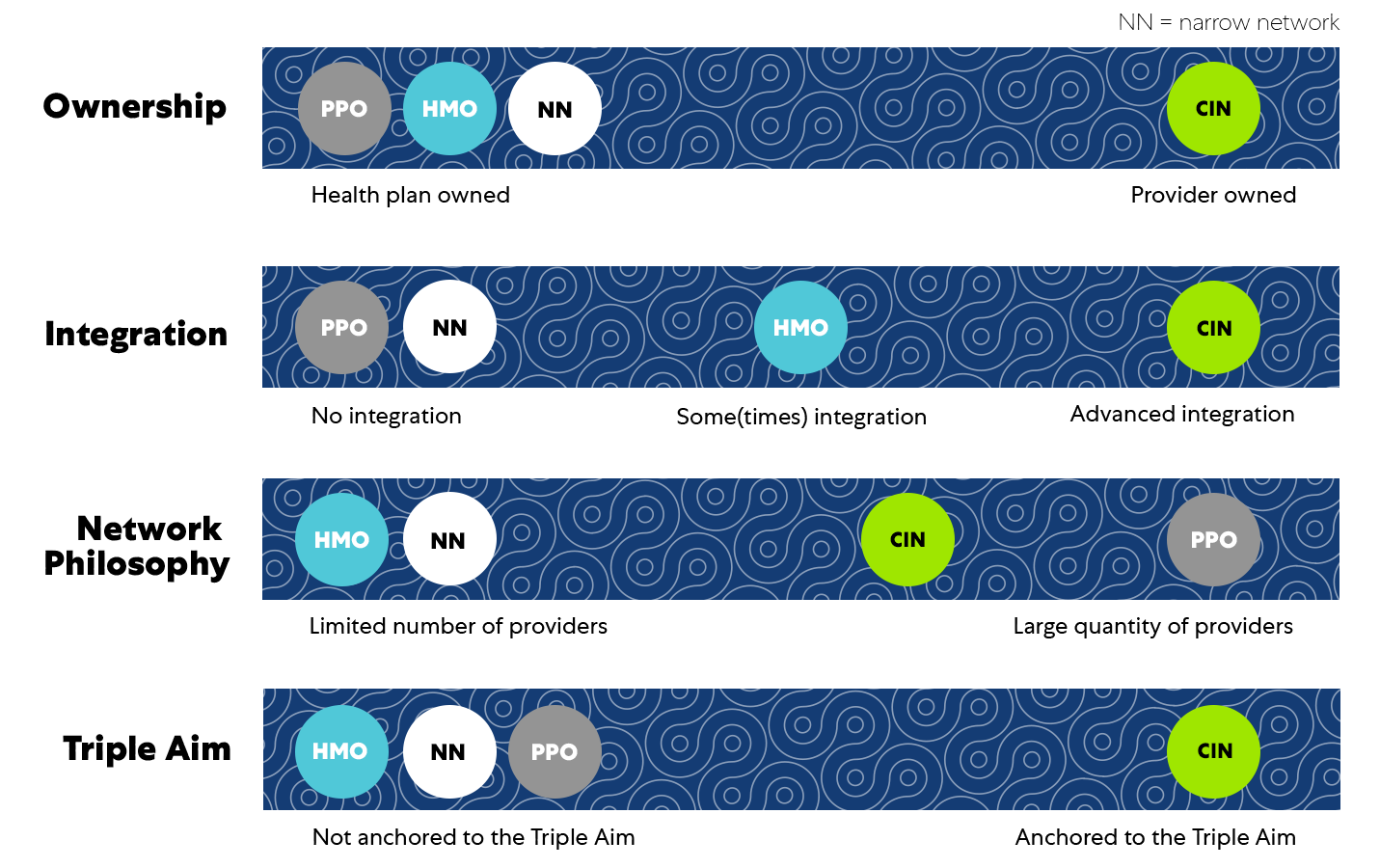
The difference between a preferred provider organization (PPO), health maintenance organization (HMO), narrow network, and clinically integrated network (CIN)
Provider networks are built differently and it’s important to know their unique features
Josh Walker, JD, Director of Network Development
Healthcare is famously complicated. If you are hearing about Embright for the first time, you may be wondering, “what the heck is a clinically integrated network, and why would I want that anyway?” The goal of this article is to answer those questions and hopefully relieve some of the stress around the benefits decision-making process. Let’s go over a few definitions as background.
Preferred provider organization (PPO)
As is often the case in healthcare, the name “preferred provider organization” does not explain what a PPO is. PPOs are not “provider organizations”, in fact, they are rarely stand-alone organizations at all, and they don’t show any real preference for particular providers. Healthcare.gov defines a PPO simply as “A type of health plan that contracts with medical providers, such as hospitals and doctors, to create a network of participating providers.”1
In practice, PPOs are wide networks of providers that are brought together most often by insurance companies to have as many providers included as possible, regardless of quality. Because they are managed by insurance companies, rates are based not on what healthcare actually costs but on negotiation leverage. Bigger providers and bigger insurers tend to have more leverage in dictating rates. Whatever rates are agreed to across the network, the insurance company then takes a percentage off the top. The net result is high cost and poorly integrated care.
Narrow Networks
After some time putting up with the high cost and poorly integrated care of a PPO, often employers start to wonder if something better might be out there. When this happens, insurance companies like to throw out the option of “narrow networks” to retain the business. Consumer Reports defines narrow networks as “(plans) with a smaller pool of doctors, hospitals, and treatment centers, who agree to a lower price for services with the expectation that they will get greater patient volume.”2
Narrow networks are essentially a small subset of a PPO network. Providers are chosen to participate in narrow networks, not based on their performance or quality of care, but based again on negotiation leverage. An insurer picks up the phone and asks “Dr. X, are you willing to take 25% less to keep seeing the same patients? If so great, you’re in the narrow network now!” There is no integration between providers in a narrow network, their participation is just a piece of paper.
Less commonly known is that providers with more leverage may be included in a narrow network at the same rate as their PPO contract allows. From the employer’s perspective, their employees are giving up access to the vast majority of providers in the market and the employer may end up spending the same amount depending on where care services are rendered. Members meanwhile, if they are even aware they selected a narrow network, suddenly find themselves with a massively restricted network of providers, but one with no coordination between them.
Health maintenance organization (HMO)
By its name, you might expect that an HMO is something provider-ran, or maybe that it’s a trendy juice bar downtown. In fact, it can be any number of things. Healthcare.gov defines an HMO simply as, “a type of health insurance plan that usually limits coverage to care from doctors who work for or contract with the HMO.”3 This looks and feels a lot like a narrow network, and is indeed very similar with some defining differences.
HMOs often point to their ability to coordinate care. While some integration of care may occur within particular HMO plans, the results vary wildly. A 2018 report commissioned by the New Jersey Department of Health found that PPOs actually outperformed HMOs across many key HEDIS measures, such as Cervical Cancer Screening and Well-Child visits.4
HMOs are also well-known for the restrictions they place on members, beyond what you might find in a narrow network plan. The combination of strict rules on the member and a limited network of providers is meant to result in lower costs, but without thoughtfulness around providers in the network or integration, HMOs often only end up offering bad member experiences.

Clinically integrated network (CIN)
So, what makes a clinically integrated network or CIN different?
For starters, CINs are what their name implies. They are a network of providers that integrate together in meaningful ways to improve clinical outcomes and performance. CINs like Embright are provider-ran, provider-owned, stand-alone legal entities that reward providers for giving better care, not for being bigger or for billing more.
Embright, the largest CIN in the Pacific Northwest, takes this approach a step further and integrates provider data using the latest technology to provide real-time insights to providers on how they are doing. Embright uses the best practices in care management to make sure that our patients receive the right care and aren’t left wondering how to navigate the system. The Embright network combines the top health systems in Washington, finding the sweet spot of a large but curated number of quality providers, working together across organizations to improve healthcare. We then put our money where our mouth is and work directly with employers and purchasers interested in paying for value and quality rather than remaining in the broken world of fee-for-service care. Said differently, CINs are unique in healthcare as they are by design incentivized to pursue the Triple Aim of lower cost, higher quality, and a better member experience.
Hopefully, these definitions help clear up some of the confusion that we all run into in navigating healthcare jargon and how a clinically integrated network, like its name, is intentionally built to reward providers to deliver high-quality care and in turn help members get and stay healthy.
1 - Preferred Provider Organization (PPO). https://www.healthcare.gov/glossary/preferred-provider-organization-ppo/#:~:text=A%20type%20of%20health%20plan,belong%20to%20the%20plan's%20network
2 - What to Know About Narrow Network Health Insurance Plans. https://www.consumerreports.org/health-insurance/what-to-know-about-narrow-network-health-insurance-plans/#:~:text=Known%20as%20narrow%20network%20plans,down%20the%20premiums%20consumers%20pay
3 - Health Maintenance Organization (HMO). https://www.healthcare.gov/glossary/health-maintenance-organization-hmo/#:~:text=A%20type%20of%20health%20insurance,to%20be%20eligible%20for%20coverage
4 - 2018 New Jersey HMO & PPO Performance Report. https://www.state.nj.us/dobi/lifehealthactuarial/hmo2018/2018HMO_PPOPerformanceReport.pdf
Related Content

MYTH BUSTING! The direct contracting difference

New independent providers now a part of Embright
